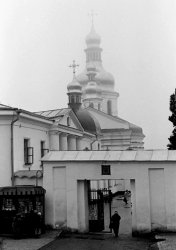A TIME OF GATHERING STONES TOGETHER Another church restored at Kyiv Pechersk Monastery

The church is located by the entrance to the nearby caves and its history is quite interesting. The Khrestovozdvyzhenska Church (its shortened name in Ukrainian) was erected a very long time ago, pilgrims have come here to cleanse their souls with prayer before paying homage to the remains of the monastery's saints in the caves. There were three passages to the caves leading from the church. All are well preserved but currently barred to the laity. Originally, the church was built of timber and often caught fire, being promptly rebuilt each time. In 1700, under Hetman Ivan Mazepa, it was rebuilt, this time of stone, and this structure with minor modifications, has reached our day. It will soon be 300 years old. The construction project was financed, as a free donation, by Colonel Pavlo Hertsyck of Poltava, who came from a prominent Jewish Cossack family. His son, Hryhory, was a registered Cossack colonel, also in Poltava, serving directly under Mazepa (he would eventually follow him to exile). Later, he served as senior osavul (literally meaning captain, but in this case an aide-de-camp or even adjutant general) under Hetman Pylyp Orlyk, then his son-in-law. Still later, Hryhory Hertsyck suffered Princess Tarakanova's lot. Pylyp Orlyk sent him on a secret mission to Warsaw. There he was abducted by the Russian Ambassador, Prince Dolgoruky (Warsaw was not yet part of the Russian Empire), brought to St. Petersburg and held in the Fortress of Peter and Paul. His father did not live to see all this as he died shortly after the church was consecrated and was buried on the premises. There is a gravestone with his name, sunk in the wall not far from the entrance...
Let us now return to our own time. Says Bishop Pavlo (Lebid), Father Superior of the Monastery, "The four-year renovation project, including interior decorations, costs Hr 2.5 million in all. Almost all work was done by experts from the Ukrrestavratsiya Ukrainian Restoration Institute and we at the monastery do appreciate their skill and dedication. Doing the big fretwork iconostasis was especially difficult as it had lost 400 delicate components. Just imagine, they were all pasted over with clay! It took the experts several years to carve the missing elements which had then to be glued on, varnished and gilded. Now gilding techniques are very sophisticated, and the thickness of gold foil is measured in microns. The ciboriums and nimbi of the saints were also gilded. The altar decorated with four bas-reliefs portraying scenes from the Passion is especially charming. Interior decorations took more than 4 kg of gold. Another 5 kilograms went for the three domes of the church. They did a good job on the domes, making them shine for another century. I might as well tell you that a considerable part of gold for gilding was donated by monasteries in Russia."
The renovation work seems to have lifted some dark sinister veil off the church which used to hide, nay distort its beauty. Only now one can fully appreciate its architecture, placement, and ornament. The church stands flush to the hill secreting the nearby caves, as though part of them, repeating their wavy contours. Its interior is not characteristic of an Eastern Orthodox House of God. It is rather oblong and vaulted Gothic-like. Looking at the three-tier iconostasis one has the impression that it reaches the vault of the central cupola symbolizing Heaven. Because of its considerable height the church looks smaller than it really is, accommodating over 300 faithful on religious holidays.
Among its most sacred relics are the Thaumaturgic Icon of the Dormition and fragments of the Holy Cross. The icon is mounted high over the altar screen and twice a day is solemnly lowered for the adherents to pray in front of it. The cloistered brothers believe that it is a copy of the icon made by Old Rus' painter Alimpiy. The fragments of the Holy Cross are kept in the ciborium of the Exaltation icon on the iconostasis. This relic was presented to the monastery last year by Patriarch Diodorus of Jerusalem.
One other detail. The Exaltation Church was restored simultaneously with a small annex crowned by a miniature dome, located to the right of the entrance. It is not a chapel but a passage to the monastery basement in which sacramental wine had always been stored. It is there now, too, except that previously this wine was made at every monastery. Not now. Fortunately, there are still Good Samaritans to be found in this world. Father Pavlo says that this year the monastery received a shipment from the Moldovan Church. What kind of wine? Canon reads that consecrated wine must be pure dry grape wine, without any admixtures. Also, it must be red, like the blood of Jesus Christ into which this wine miraculously transforms during the Liturgy. And so their Moldovan benefactors delivered 12,000 bottles of 3-year-old Cagor (resembling Chianti). Precisely the amount needed by the monastery's churches where thousands come for Holy Communion.
Any other restoration plans? To this Father Pavlo replies that the immediate priorities include cleaning drinking wells and springs on the premises, and cleaning means also properly equipping, decorating, and building chapels over them. Restoration work at the Lower Church (once called St. Irene's Church) is nearing completion. It had to be literally dug up from under several meters of debris. Soon it will be consecrated and named the Life-Giving Spring. Sounds symbolic.
Photo by Oleksiy Stasenko, The Day
Newspaper output №:
№1, (1998)Section
Culture





